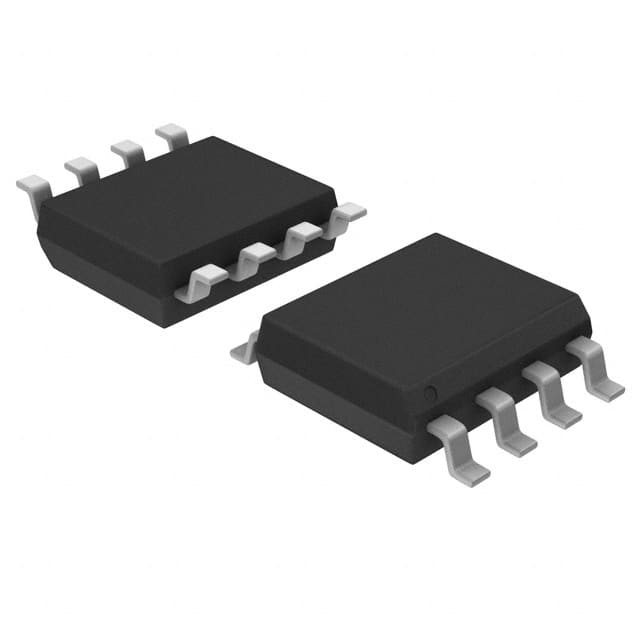Lihat spesifikasi untuk detail produk.

MIC5156-5.0BM
Product Overview
Category
MIC5156-5.0BM belongs to the category of voltage regulators.
Use
It is primarily used for regulating voltage in electronic circuits.
Characteristics
- Package: The MIC5156-5.0BM comes in a compact surface-mount package.
- Essence: This voltage regulator provides a stable output voltage under varying input conditions.
- Packaging/Quantity: It is typically available in reels or tubes, with quantities varying based on customer requirements.
Specifications
The specifications of MIC5156-5.0BM are as follows:
- Input Voltage Range: 7V to 30V
- Output Voltage: 5.0V
- Output Current: Up to 150mA
- Dropout Voltage: 300mV (typical)
- Line Regulation: ±0.2% (typical)
- Load Regulation: ±0.4% (typical)
- Quiescent Current: 120µA (typical)
Pin Configuration
The pin configuration of MIC5156-5.0BM is as follows:
- VIN - Input Voltage
- GND - Ground
- VOUT - Output Voltage
Functional Features
- Low Dropout: The MIC5156-5.0BM exhibits low dropout voltage, ensuring efficient regulation even when the input voltage is close to the desired output voltage.
- Low Quiescent Current: With a low quiescent current, this voltage regulator minimizes power consumption during standby or idle modes.
- Thermal Shutdown Protection: The device incorporates thermal shutdown protection, preventing damage due to excessive temperature.
Advantages and Disadvantages
Advantages
- Stable Output: MIC5156-5.0BM provides a stable 5.0V output voltage, ensuring reliable operation of connected components.
- Wide Input Voltage Range: It can accept input voltages ranging from 7V to 30V, making it suitable for various applications.
- Low Quiescent Current: The low quiescent current helps conserve power and extend battery life.
Disadvantages
- Limited Output Current: The maximum output current of 150mA may not be sufficient for high-power applications.
- Dropout Voltage: The dropout voltage of 300mV may limit its usability in scenarios where a lower dropout is required.
Working Principles
MIC5156-5.0BM operates based on the principle of linear voltage regulation. It utilizes a pass transistor to regulate the output voltage by adjusting the resistance between the input and output terminals. This ensures that the output voltage remains constant despite variations in the input voltage or load conditions.
Detailed Application Field Plans
MIC5156-5.0BM finds applications in various electronic systems, including but not limited to:
- Battery-Powered Devices: It can be used to regulate voltage in portable devices such as smartphones, tablets, and handheld instruments.
- Automotive Electronics: The voltage regulator can be employed in automotive applications to ensure stable power supply to sensitive components.
- Industrial Control Systems: It is suitable for use in industrial control systems, providing reliable voltage regulation for sensors, actuators, and other critical components.
Alternative Models
Several alternative models with similar functionality are available in the market. Some notable alternatives to MIC5156-5.0BM include:
- LM1117-5.0: A popular voltage regulator offering a fixed 5.0V output with low dropout and excellent line/load regulation.
- LT1763-5.0: This regulator provides a fixed 5.0V output with ultra-low dropout voltage and high PSRR (Power Supply Rejection Ratio).
- MCP1700-500: Another option with a fixed 5.0V output, low dropout voltage, and low quiescent current.
These alternative models can be considered based on specific application requirements and desired performance characteristics.
In conclusion, MIC5156-5.0BM is a voltage regulator that offers stable output voltage, wide input voltage range, and low quiescent current. It finds applications in various electronic systems and has alternative models with similar functionality available in the market.
Sebutkan 10 pertanyaan dan jawaban umum terkait penerapan MIC5156-5.0BM dalam solusi teknis
Sure! Here are 10 common questions and answers related to the application of MIC5156-5.0BM in technical solutions:
Q: What is MIC5156-5.0BM? A: MIC5156-5.0BM is a voltage regulator IC that provides a fixed output voltage of 5.0V.
Q: What is the input voltage range for MIC5156-5.0BM? A: The input voltage range for MIC5156-5.0BM is typically between 7V and 35V.
Q: What is the maximum output current of MIC5156-5.0BM? A: MIC5156-5.0BM can provide a maximum output current of 500mA.
Q: Can MIC5156-5.0BM be used in battery-powered applications? A: Yes, MIC5156-5.0BM can be used in battery-powered applications as long as the input voltage is within the specified range.
Q: Is MIC5156-5.0BM suitable for automotive applications? A: Yes, MIC5156-5.0BM is designed to operate in automotive environments and can handle the required voltage and temperature ranges.
Q: Does MIC5156-5.0BM have built-in protection features? A: Yes, MIC5156-5.0BM includes overcurrent protection, thermal shutdown, and reverse polarity protection.
Q: Can MIC5156-5.0BM be used in both step-up and step-down configurations? A: No, MIC5156-5.0BM is a step-down (buck) voltage regulator and can only reduce the input voltage to a lower fixed output voltage.
Q: What is the typical efficiency of MIC5156-5.0BM? A: The typical efficiency of MIC5156-5.0BM is around 85% to 90%, depending on the input and output voltage conditions.
Q: Can MIC5156-5.0BM be used in high-frequency switching applications? A: Yes, MIC5156-5.0BM has a fixed switching frequency of 500kHz, making it suitable for high-frequency applications.
Q: Are there any recommended external components to use with MIC5156-5.0BM? A: Yes, it is recommended to use input and output capacitors for stability and filtering purposes. The datasheet provides guidelines for selecting these components based on the application requirements.
Please note that the answers provided here are general and may vary depending on specific application requirements. It is always recommended to refer to the datasheet and consult with the manufacturer for detailed information and application-specific considerations.

